University Leadership Essay: Global Climate Change Challenges
VerifiedAdded on 2023/06/03
|17
|4558
|292
Essay
AI Summary
This essay explores the application of leadership principles to the 'wicked problem' of global climate change. It begins by defining wicked problems and their characteristics, then specifically addresses global climate change. The essay identifies critical leadership issues necessary for resolving this complex challenge, such as competency, creativity, vision, collaboration, entrepreneurial abilities, and strategic thinking. It critically applies these leadership issues to the problem, examining how scientists, environmental agencies, and governmental bodies can employ these principles. The essay further justifies the relevance of these leadership issues, emphasizing the importance of strategy, vision, and system thinking. Finally, it proposes a leadership approach and framework, including team development and information dissemination, and explains how this framework can contribute to finding solutions to the challenges of global climate change. The essay concludes by emphasizing the crucial role of leadership in addressing this critical global issue.
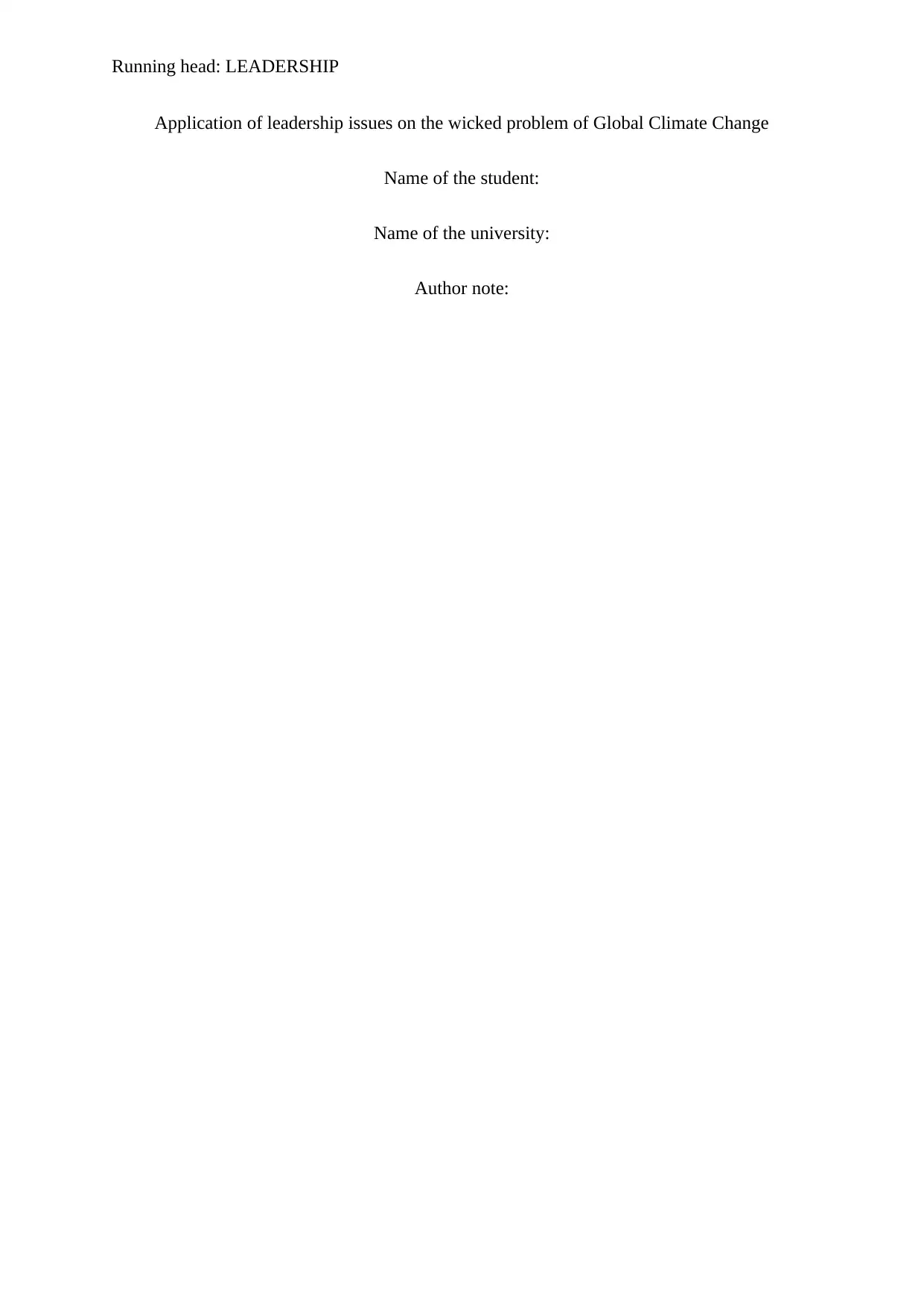
Running head: LEADERSHIP
Application of leadership issues on the wicked problem of Global Climate Change
Name of the student:
Name of the university:
Author note:
Application of leadership issues on the wicked problem of Global Climate Change
Name of the student:
Name of the university:
Author note:
Paraphrase This Document
Need a fresh take? Get an instant paraphrase of this document with our AI Paraphraser
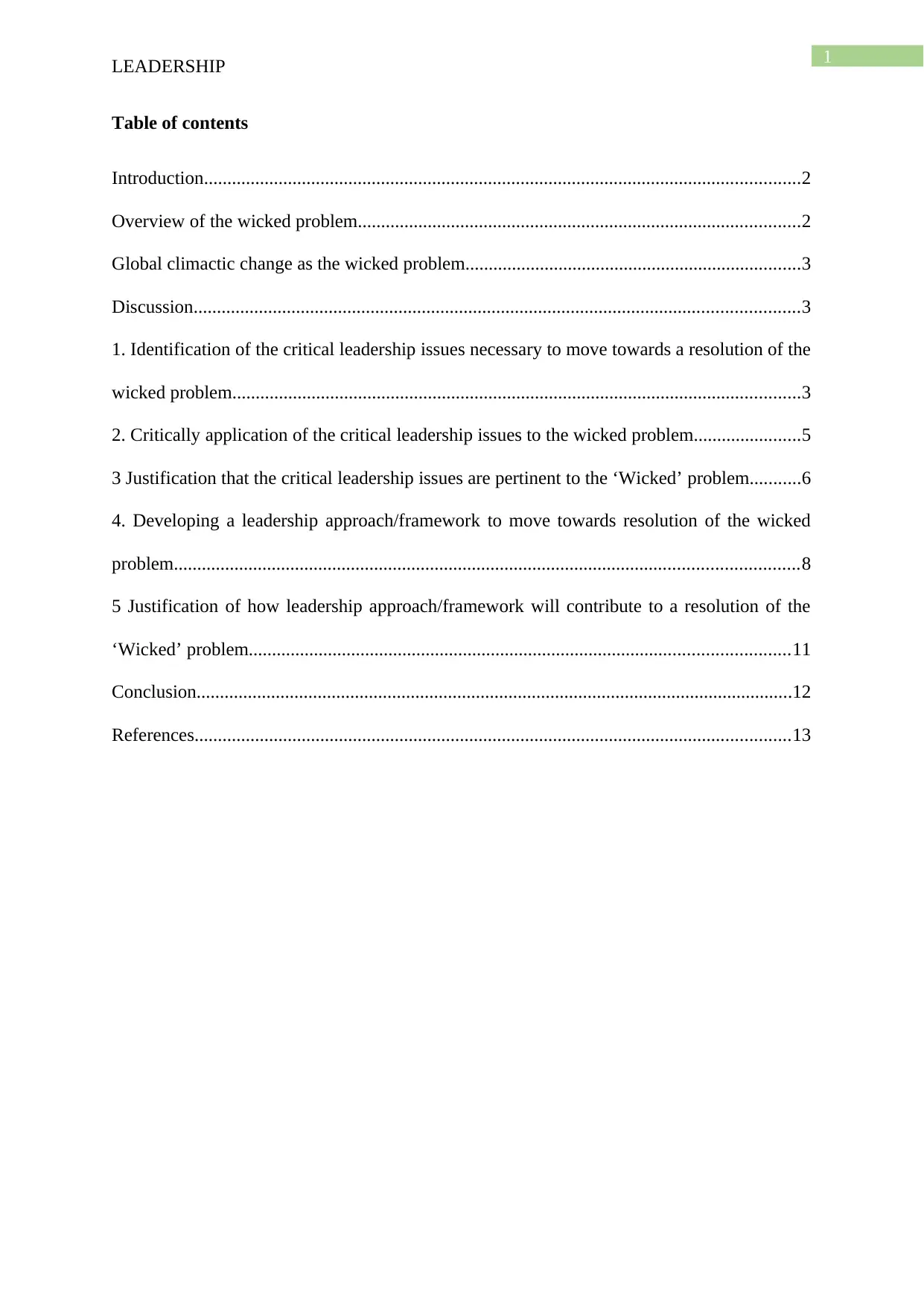
1
LEADERSHIP
Table of contents
Introduction................................................................................................................................2
Overview of the wicked problem...............................................................................................2
Global climactic change as the wicked problem........................................................................3
Discussion..................................................................................................................................3
1. Identification of the critical leadership issues necessary to move towards a resolution of the
wicked problem..........................................................................................................................3
2. Critically application of the critical leadership issues to the wicked problem.......................5
3 Justification that the critical leadership issues are pertinent to the ‘Wicked’ problem...........6
4. Developing a leadership approach/framework to move towards resolution of the wicked
problem......................................................................................................................................8
5 Justification of how leadership approach/framework will contribute to a resolution of the
‘Wicked’ problem....................................................................................................................11
Conclusion................................................................................................................................12
References................................................................................................................................13
LEADERSHIP
Table of contents
Introduction................................................................................................................................2
Overview of the wicked problem...............................................................................................2
Global climactic change as the wicked problem........................................................................3
Discussion..................................................................................................................................3
1. Identification of the critical leadership issues necessary to move towards a resolution of the
wicked problem..........................................................................................................................3
2. Critically application of the critical leadership issues to the wicked problem.......................5
3 Justification that the critical leadership issues are pertinent to the ‘Wicked’ problem...........6
4. Developing a leadership approach/framework to move towards resolution of the wicked
problem......................................................................................................................................8
5 Justification of how leadership approach/framework will contribute to a resolution of the
‘Wicked’ problem....................................................................................................................11
Conclusion................................................................................................................................12
References................................................................................................................................13
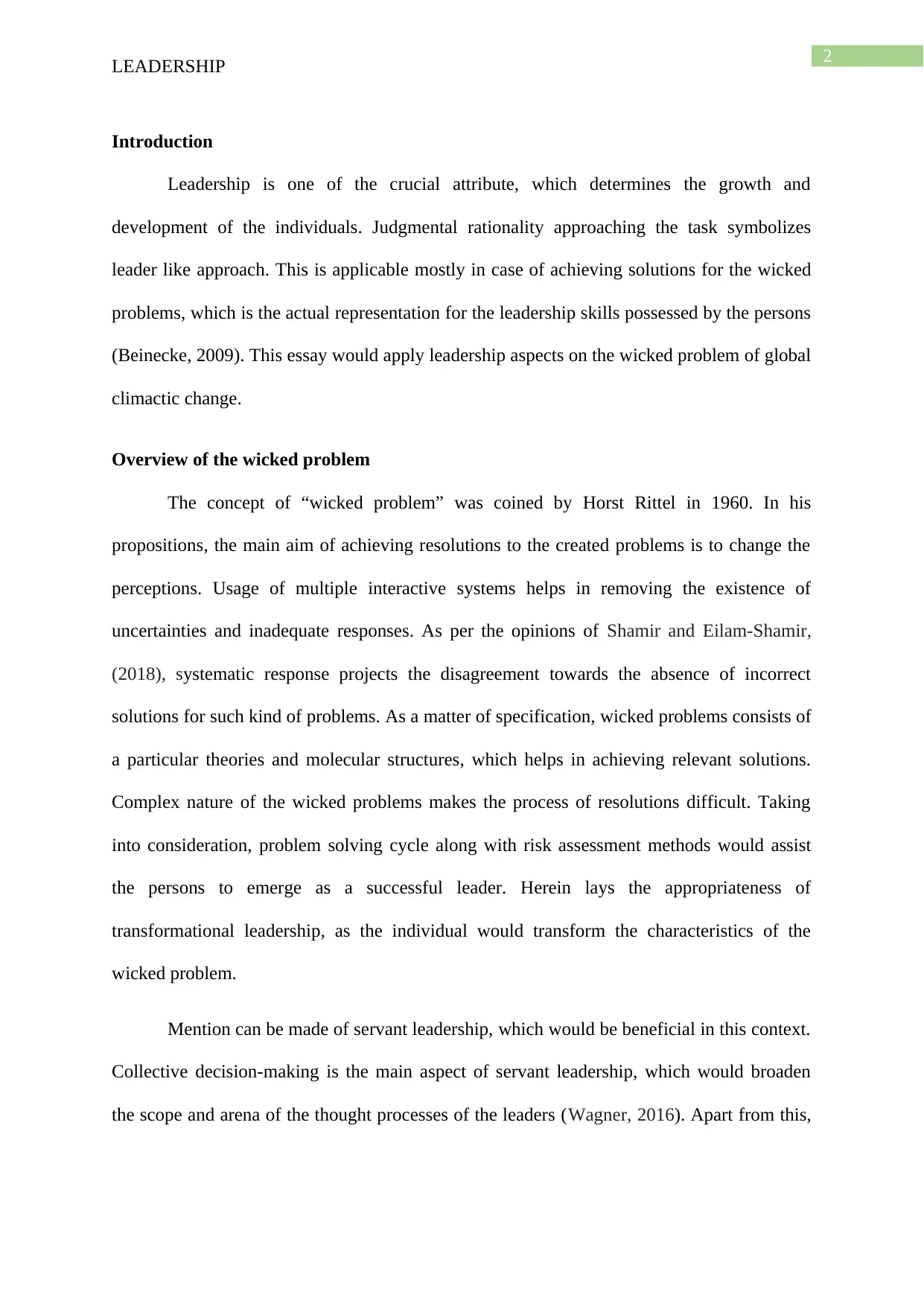
2
LEADERSHIP
Introduction
Leadership is one of the crucial attribute, which determines the growth and
development of the individuals. Judgmental rationality approaching the task symbolizes
leader like approach. This is applicable mostly in case of achieving solutions for the wicked
problems, which is the actual representation for the leadership skills possessed by the persons
(Beinecke, 2009). This essay would apply leadership aspects on the wicked problem of global
climactic change.
Overview of the wicked problem
The concept of “wicked problem” was coined by Horst Rittel in 1960. In his
propositions, the main aim of achieving resolutions to the created problems is to change the
perceptions. Usage of multiple interactive systems helps in removing the existence of
uncertainties and inadequate responses. As per the opinions of Shamir and Eilam-Shamir,
(2018), systematic response projects the disagreement towards the absence of incorrect
solutions for such kind of problems. As a matter of specification, wicked problems consists of
a particular theories and molecular structures, which helps in achieving relevant solutions.
Complex nature of the wicked problems makes the process of resolutions difficult. Taking
into consideration, problem solving cycle along with risk assessment methods would assist
the persons to emerge as a successful leader. Herein lays the appropriateness of
transformational leadership, as the individual would transform the characteristics of the
wicked problem.
Mention can be made of servant leadership, which would be beneficial in this context.
Collective decision-making is the main aspect of servant leadership, which would broaden
the scope and arena of the thought processes of the leaders (Wagner, 2016). Apart from this,
LEADERSHIP
Introduction
Leadership is one of the crucial attribute, which determines the growth and
development of the individuals. Judgmental rationality approaching the task symbolizes
leader like approach. This is applicable mostly in case of achieving solutions for the wicked
problems, which is the actual representation for the leadership skills possessed by the persons
(Beinecke, 2009). This essay would apply leadership aspects on the wicked problem of global
climactic change.
Overview of the wicked problem
The concept of “wicked problem” was coined by Horst Rittel in 1960. In his
propositions, the main aim of achieving resolutions to the created problems is to change the
perceptions. Usage of multiple interactive systems helps in removing the existence of
uncertainties and inadequate responses. As per the opinions of Shamir and Eilam-Shamir,
(2018), systematic response projects the disagreement towards the absence of incorrect
solutions for such kind of problems. As a matter of specification, wicked problems consists of
a particular theories and molecular structures, which helps in achieving relevant solutions.
Complex nature of the wicked problems makes the process of resolutions difficult. Taking
into consideration, problem solving cycle along with risk assessment methods would assist
the persons to emerge as a successful leader. Herein lays the appropriateness of
transformational leadership, as the individual would transform the characteristics of the
wicked problem.
Mention can be made of servant leadership, which would be beneficial in this context.
Collective decision-making is the main aspect of servant leadership, which would broaden
the scope and arena of the thought processes of the leaders (Wagner, 2016). Apart from this,
⊘ This is a preview!⊘
Do you want full access?
Subscribe today to unlock all pages.

Trusted by 1+ million students worldwide
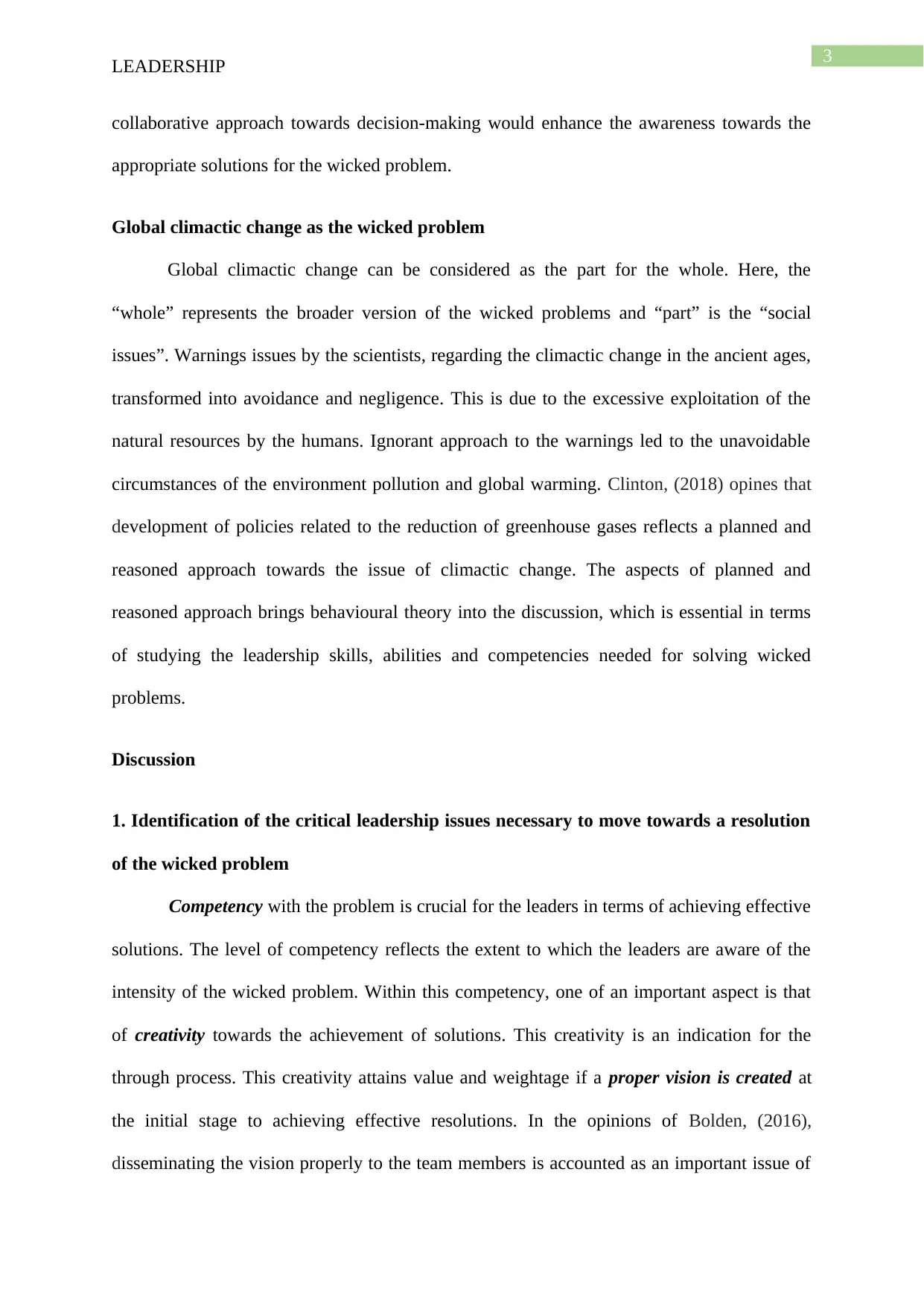
3
LEADERSHIP
collaborative approach towards decision-making would enhance the awareness towards the
appropriate solutions for the wicked problem.
Global climactic change as the wicked problem
Global climactic change can be considered as the part for the whole. Here, the
“whole” represents the broader version of the wicked problems and “part” is the “social
issues”. Warnings issues by the scientists, regarding the climactic change in the ancient ages,
transformed into avoidance and negligence. This is due to the excessive exploitation of the
natural resources by the humans. Ignorant approach to the warnings led to the unavoidable
circumstances of the environment pollution and global warming. Clinton, (2018) opines that
development of policies related to the reduction of greenhouse gases reflects a planned and
reasoned approach towards the issue of climactic change. The aspects of planned and
reasoned approach brings behavioural theory into the discussion, which is essential in terms
of studying the leadership skills, abilities and competencies needed for solving wicked
problems.
Discussion
1. Identification of the critical leadership issues necessary to move towards a resolution
of the wicked problem
Competency with the problem is crucial for the leaders in terms of achieving effective
solutions. The level of competency reflects the extent to which the leaders are aware of the
intensity of the wicked problem. Within this competency, one of an important aspect is that
of creativity towards the achievement of solutions. This creativity is an indication for the
through process. This creativity attains value and weightage if a proper vision is created at
the initial stage to achieving effective resolutions. In the opinions of Bolden, (2016),
disseminating the vision properly to the team members is accounted as an important issue of
LEADERSHIP
collaborative approach towards decision-making would enhance the awareness towards the
appropriate solutions for the wicked problem.
Global climactic change as the wicked problem
Global climactic change can be considered as the part for the whole. Here, the
“whole” represents the broader version of the wicked problems and “part” is the “social
issues”. Warnings issues by the scientists, regarding the climactic change in the ancient ages,
transformed into avoidance and negligence. This is due to the excessive exploitation of the
natural resources by the humans. Ignorant approach to the warnings led to the unavoidable
circumstances of the environment pollution and global warming. Clinton, (2018) opines that
development of policies related to the reduction of greenhouse gases reflects a planned and
reasoned approach towards the issue of climactic change. The aspects of planned and
reasoned approach brings behavioural theory into the discussion, which is essential in terms
of studying the leadership skills, abilities and competencies needed for solving wicked
problems.
Discussion
1. Identification of the critical leadership issues necessary to move towards a resolution
of the wicked problem
Competency with the problem is crucial for the leaders in terms of achieving effective
solutions. The level of competency reflects the extent to which the leaders are aware of the
intensity of the wicked problem. Within this competency, one of an important aspect is that
of creativity towards the achievement of solutions. This creativity is an indication for the
through process. This creativity attains value and weightage if a proper vision is created at
the initial stage to achieving effective resolutions. In the opinions of Bolden, (2016),
disseminating the vision properly to the team members is accounted as an important issue of
Paraphrase This Document
Need a fresh take? Get an instant paraphrase of this document with our AI Paraphraser
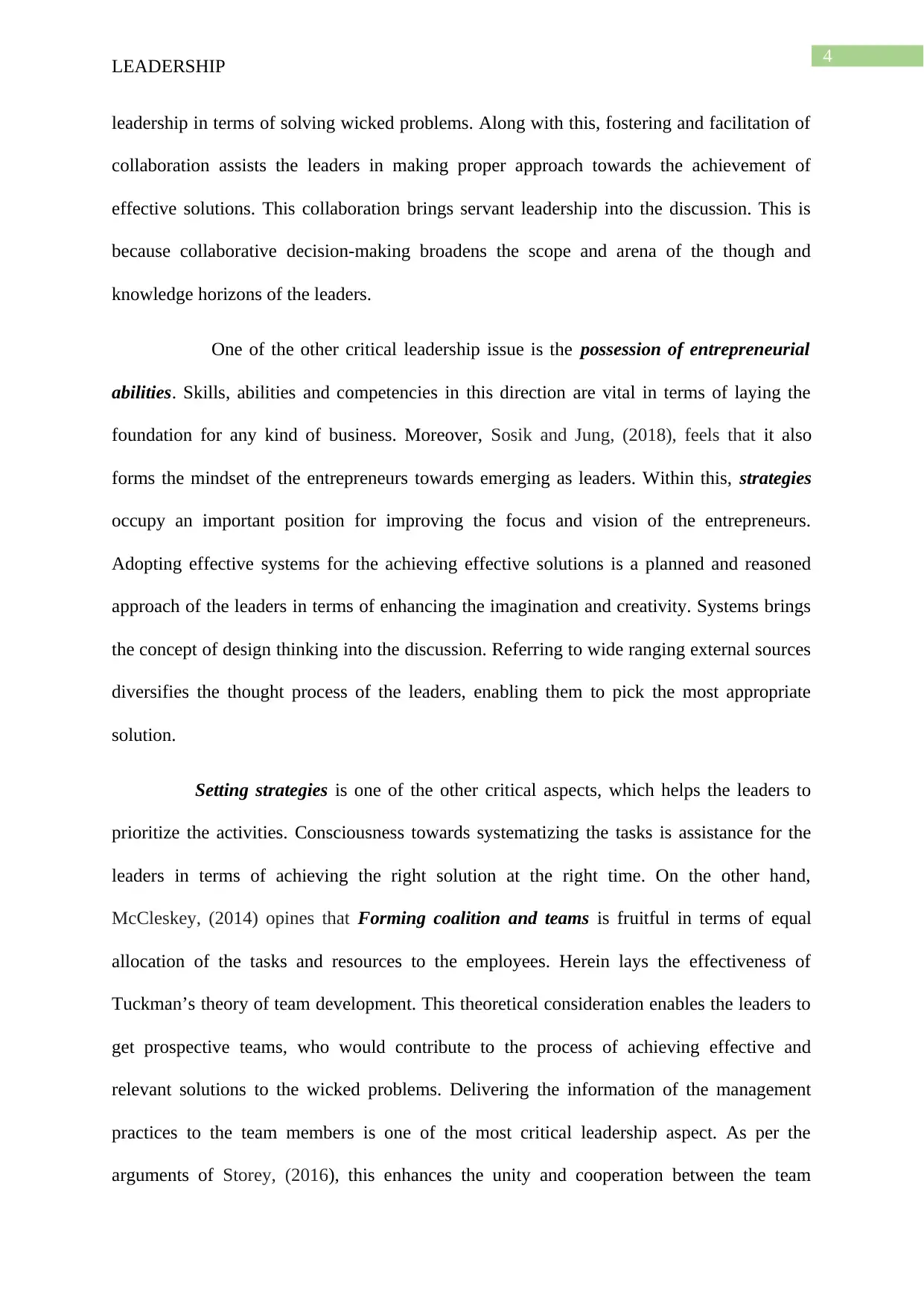
4
LEADERSHIP
leadership in terms of solving wicked problems. Along with this, fostering and facilitation of
collaboration assists the leaders in making proper approach towards the achievement of
effective solutions. This collaboration brings servant leadership into the discussion. This is
because collaborative decision-making broadens the scope and arena of the though and
knowledge horizons of the leaders.
One of the other critical leadership issue is the possession of entrepreneurial
abilities. Skills, abilities and competencies in this direction are vital in terms of laying the
foundation for any kind of business. Moreover, Sosik and Jung, (2018), feels that it also
forms the mindset of the entrepreneurs towards emerging as leaders. Within this, strategies
occupy an important position for improving the focus and vision of the entrepreneurs.
Adopting effective systems for the achieving effective solutions is a planned and reasoned
approach of the leaders in terms of enhancing the imagination and creativity. Systems brings
the concept of design thinking into the discussion. Referring to wide ranging external sources
diversifies the thought process of the leaders, enabling them to pick the most appropriate
solution.
Setting strategies is one of the other critical aspects, which helps the leaders to
prioritize the activities. Consciousness towards systematizing the tasks is assistance for the
leaders in terms of achieving the right solution at the right time. On the other hand,
McCleskey, (2014) opines that Forming coalition and teams is fruitful in terms of equal
allocation of the tasks and resources to the employees. Herein lays the effectiveness of
Tuckman’s theory of team development. This theoretical consideration enables the leaders to
get prospective teams, who would contribute to the process of achieving effective and
relevant solutions to the wicked problems. Delivering the information of the management
practices to the team members is one of the most critical leadership aspect. As per the
arguments of Storey, (2016), this enhances the unity and cooperation between the team
LEADERSHIP
leadership in terms of solving wicked problems. Along with this, fostering and facilitation of
collaboration assists the leaders in making proper approach towards the achievement of
effective solutions. This collaboration brings servant leadership into the discussion. This is
because collaborative decision-making broadens the scope and arena of the though and
knowledge horizons of the leaders.
One of the other critical leadership issue is the possession of entrepreneurial
abilities. Skills, abilities and competencies in this direction are vital in terms of laying the
foundation for any kind of business. Moreover, Sosik and Jung, (2018), feels that it also
forms the mindset of the entrepreneurs towards emerging as leaders. Within this, strategies
occupy an important position for improving the focus and vision of the entrepreneurs.
Adopting effective systems for the achieving effective solutions is a planned and reasoned
approach of the leaders in terms of enhancing the imagination and creativity. Systems brings
the concept of design thinking into the discussion. Referring to wide ranging external sources
diversifies the thought process of the leaders, enabling them to pick the most appropriate
solution.
Setting strategies is one of the other critical aspects, which helps the leaders to
prioritize the activities. Consciousness towards systematizing the tasks is assistance for the
leaders in terms of achieving the right solution at the right time. On the other hand,
McCleskey, (2014) opines that Forming coalition and teams is fruitful in terms of equal
allocation of the tasks and resources to the employees. Herein lays the effectiveness of
Tuckman’s theory of team development. This theoretical consideration enables the leaders to
get prospective teams, who would contribute to the process of achieving effective and
relevant solutions to the wicked problems. Delivering the information of the management
practices to the team members is one of the most critical leadership aspect. As per the
arguments of Storey, (2016), this enhances the unity and cooperation between the team
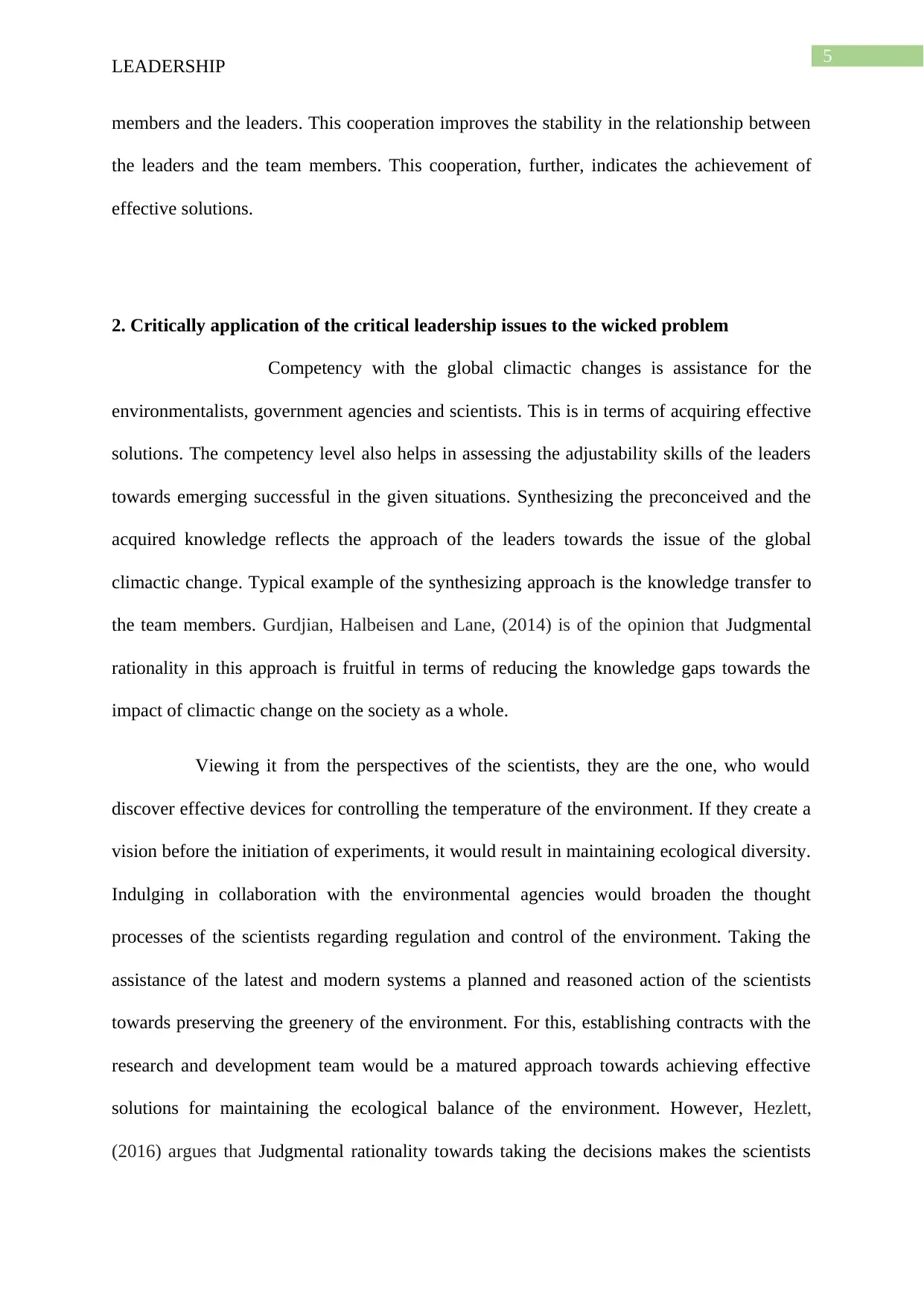
5
LEADERSHIP
members and the leaders. This cooperation improves the stability in the relationship between
the leaders and the team members. This cooperation, further, indicates the achievement of
effective solutions.
2. Critically application of the critical leadership issues to the wicked problem
Competency with the global climactic changes is assistance for the
environmentalists, government agencies and scientists. This is in terms of acquiring effective
solutions. The competency level also helps in assessing the adjustability skills of the leaders
towards emerging successful in the given situations. Synthesizing the preconceived and the
acquired knowledge reflects the approach of the leaders towards the issue of the global
climactic change. Typical example of the synthesizing approach is the knowledge transfer to
the team members. Gurdjian, Halbeisen and Lane, (2014) is of the opinion that Judgmental
rationality in this approach is fruitful in terms of reducing the knowledge gaps towards the
impact of climactic change on the society as a whole.
Viewing it from the perspectives of the scientists, they are the one, who would
discover effective devices for controlling the temperature of the environment. If they create a
vision before the initiation of experiments, it would result in maintaining ecological diversity.
Indulging in collaboration with the environmental agencies would broaden the thought
processes of the scientists regarding regulation and control of the environment. Taking the
assistance of the latest and modern systems a planned and reasoned action of the scientists
towards preserving the greenery of the environment. For this, establishing contracts with the
research and development team would be a matured approach towards achieving effective
solutions for maintaining the ecological balance of the environment. However, Hezlett,
(2016) argues that Judgmental rationality towards taking the decisions makes the scientists
LEADERSHIP
members and the leaders. This cooperation improves the stability in the relationship between
the leaders and the team members. This cooperation, further, indicates the achievement of
effective solutions.
2. Critically application of the critical leadership issues to the wicked problem
Competency with the global climactic changes is assistance for the
environmentalists, government agencies and scientists. This is in terms of acquiring effective
solutions. The competency level also helps in assessing the adjustability skills of the leaders
towards emerging successful in the given situations. Synthesizing the preconceived and the
acquired knowledge reflects the approach of the leaders towards the issue of the global
climactic change. Typical example of the synthesizing approach is the knowledge transfer to
the team members. Gurdjian, Halbeisen and Lane, (2014) is of the opinion that Judgmental
rationality in this approach is fruitful in terms of reducing the knowledge gaps towards the
impact of climactic change on the society as a whole.
Viewing it from the perspectives of the scientists, they are the one, who would
discover effective devices for controlling the temperature of the environment. If they create a
vision before the initiation of experiments, it would result in maintaining ecological diversity.
Indulging in collaboration with the environmental agencies would broaden the thought
processes of the scientists regarding regulation and control of the environment. Taking the
assistance of the latest and modern systems a planned and reasoned action of the scientists
towards preserving the greenery of the environment. For this, establishing contracts with the
research and development team would be a matured approach towards achieving effective
solutions for maintaining the ecological balance of the environment. However, Hezlett,
(2016) argues that Judgmental rationality towards taking the decisions makes the scientists
⊘ This is a preview!⊘
Do you want full access?
Subscribe today to unlock all pages.

Trusted by 1+ million students worldwide
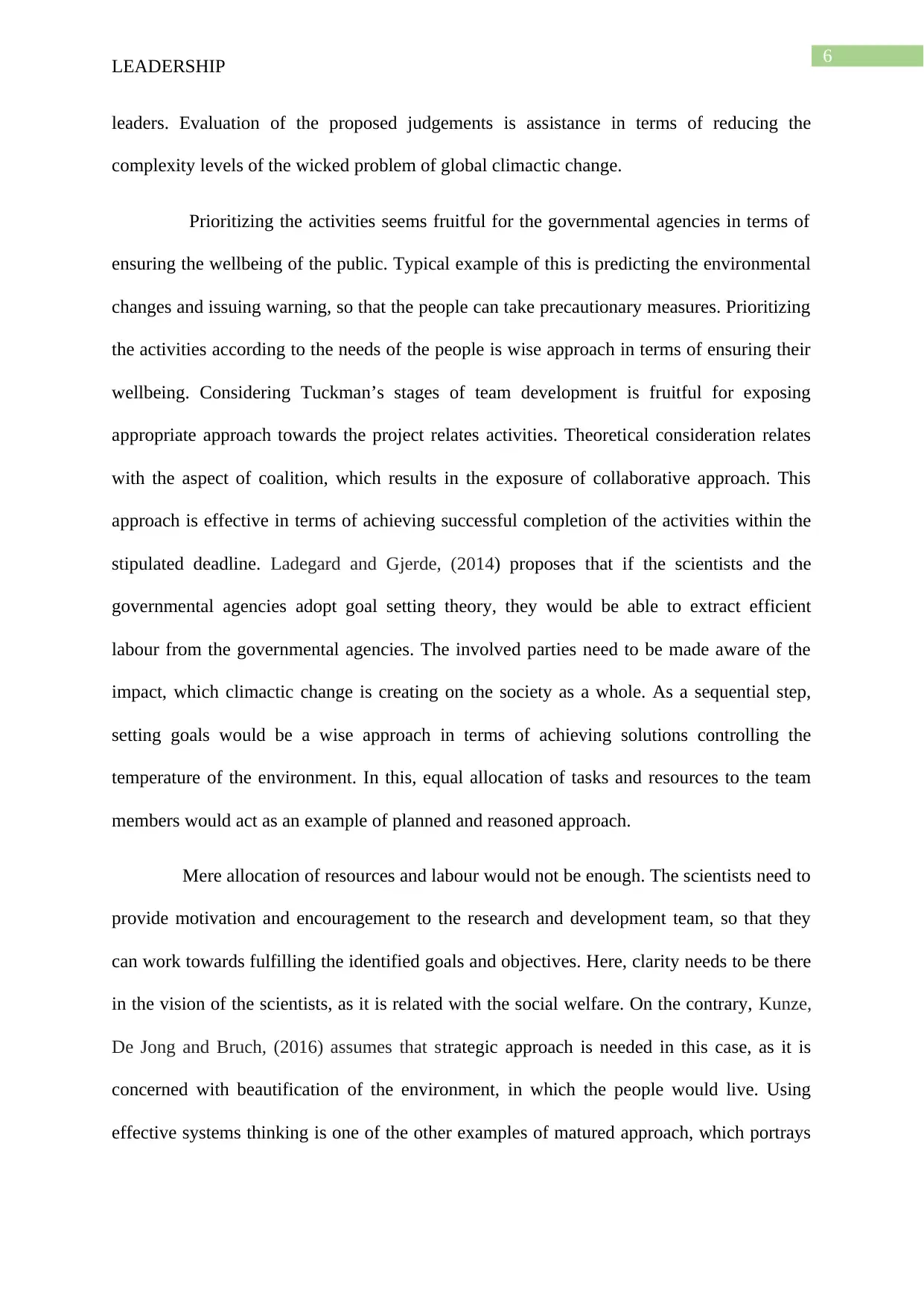
6
LEADERSHIP
leaders. Evaluation of the proposed judgements is assistance in terms of reducing the
complexity levels of the wicked problem of global climactic change.
Prioritizing the activities seems fruitful for the governmental agencies in terms of
ensuring the wellbeing of the public. Typical example of this is predicting the environmental
changes and issuing warning, so that the people can take precautionary measures. Prioritizing
the activities according to the needs of the people is wise approach in terms of ensuring their
wellbeing. Considering Tuckman’s stages of team development is fruitful for exposing
appropriate approach towards the project relates activities. Theoretical consideration relates
with the aspect of coalition, which results in the exposure of collaborative approach. This
approach is effective in terms of achieving successful completion of the activities within the
stipulated deadline. Ladegard and Gjerde, (2014) proposes that if the scientists and the
governmental agencies adopt goal setting theory, they would be able to extract efficient
labour from the governmental agencies. The involved parties need to be made aware of the
impact, which climactic change is creating on the society as a whole. As a sequential step,
setting goals would be a wise approach in terms of achieving solutions controlling the
temperature of the environment. In this, equal allocation of tasks and resources to the team
members would act as an example of planned and reasoned approach.
Mere allocation of resources and labour would not be enough. The scientists need to
provide motivation and encouragement to the research and development team, so that they
can work towards fulfilling the identified goals and objectives. Here, clarity needs to be there
in the vision of the scientists, as it is related with the social welfare. On the contrary, Kunze,
De Jong and Bruch, (2016) assumes that strategic approach is needed in this case, as it is
concerned with beautification of the environment, in which the people would live. Using
effective systems thinking is one of the other examples of matured approach, which portrays
LEADERSHIP
leaders. Evaluation of the proposed judgements is assistance in terms of reducing the
complexity levels of the wicked problem of global climactic change.
Prioritizing the activities seems fruitful for the governmental agencies in terms of
ensuring the wellbeing of the public. Typical example of this is predicting the environmental
changes and issuing warning, so that the people can take precautionary measures. Prioritizing
the activities according to the needs of the people is wise approach in terms of ensuring their
wellbeing. Considering Tuckman’s stages of team development is fruitful for exposing
appropriate approach towards the project relates activities. Theoretical consideration relates
with the aspect of coalition, which results in the exposure of collaborative approach. This
approach is effective in terms of achieving successful completion of the activities within the
stipulated deadline. Ladegard and Gjerde, (2014) proposes that if the scientists and the
governmental agencies adopt goal setting theory, they would be able to extract efficient
labour from the governmental agencies. The involved parties need to be made aware of the
impact, which climactic change is creating on the society as a whole. As a sequential step,
setting goals would be a wise approach in terms of achieving solutions controlling the
temperature of the environment. In this, equal allocation of tasks and resources to the team
members would act as an example of planned and reasoned approach.
Mere allocation of resources and labour would not be enough. The scientists need to
provide motivation and encouragement to the research and development team, so that they
can work towards fulfilling the identified goals and objectives. Here, clarity needs to be there
in the vision of the scientists, as it is related with the social welfare. On the contrary, Kunze,
De Jong and Bruch, (2016) assumes that strategic approach is needed in this case, as it is
concerned with beautification of the environment, in which the people would live. Using
effective systems thinking is one of the other examples of matured approach, which portrays
Paraphrase This Document
Need a fresh take? Get an instant paraphrase of this document with our AI Paraphraser
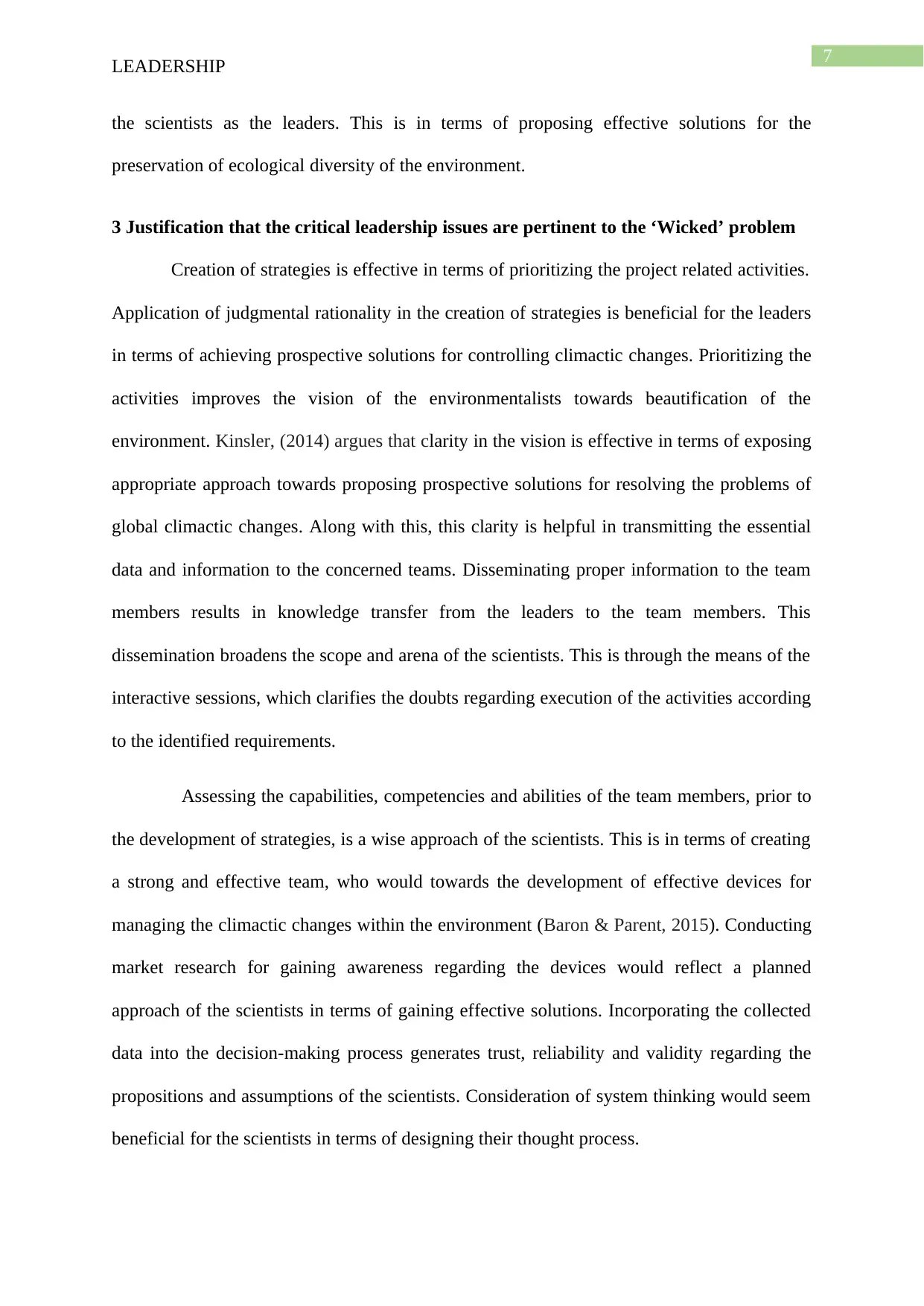
7
LEADERSHIP
the scientists as the leaders. This is in terms of proposing effective solutions for the
preservation of ecological diversity of the environment.
3 Justification that the critical leadership issues are pertinent to the ‘Wicked’ problem
Creation of strategies is effective in terms of prioritizing the project related activities.
Application of judgmental rationality in the creation of strategies is beneficial for the leaders
in terms of achieving prospective solutions for controlling climactic changes. Prioritizing the
activities improves the vision of the environmentalists towards beautification of the
environment. Kinsler, (2014) argues that clarity in the vision is effective in terms of exposing
appropriate approach towards proposing prospective solutions for resolving the problems of
global climactic changes. Along with this, this clarity is helpful in transmitting the essential
data and information to the concerned teams. Disseminating proper information to the team
members results in knowledge transfer from the leaders to the team members. This
dissemination broadens the scope and arena of the scientists. This is through the means of the
interactive sessions, which clarifies the doubts regarding execution of the activities according
to the identified requirements.
Assessing the capabilities, competencies and abilities of the team members, prior to
the development of strategies, is a wise approach of the scientists. This is in terms of creating
a strong and effective team, who would towards the development of effective devices for
managing the climactic changes within the environment (Baron & Parent, 2015). Conducting
market research for gaining awareness regarding the devices would reflect a planned
approach of the scientists in terms of gaining effective solutions. Incorporating the collected
data into the decision-making process generates trust, reliability and validity regarding the
propositions and assumptions of the scientists. Consideration of system thinking would seem
beneficial for the scientists in terms of designing their thought process.
LEADERSHIP
the scientists as the leaders. This is in terms of proposing effective solutions for the
preservation of ecological diversity of the environment.
3 Justification that the critical leadership issues are pertinent to the ‘Wicked’ problem
Creation of strategies is effective in terms of prioritizing the project related activities.
Application of judgmental rationality in the creation of strategies is beneficial for the leaders
in terms of achieving prospective solutions for controlling climactic changes. Prioritizing the
activities improves the vision of the environmentalists towards beautification of the
environment. Kinsler, (2014) argues that clarity in the vision is effective in terms of exposing
appropriate approach towards proposing prospective solutions for resolving the problems of
global climactic changes. Along with this, this clarity is helpful in transmitting the essential
data and information to the concerned teams. Disseminating proper information to the team
members results in knowledge transfer from the leaders to the team members. This
dissemination broadens the scope and arena of the scientists. This is through the means of the
interactive sessions, which clarifies the doubts regarding execution of the activities according
to the identified requirements.
Assessing the capabilities, competencies and abilities of the team members, prior to
the development of strategies, is a wise approach of the scientists. This is in terms of creating
a strong and effective team, who would towards the development of effective devices for
managing the climactic changes within the environment (Baron & Parent, 2015). Conducting
market research for gaining awareness regarding the devices would reflect a planned
approach of the scientists in terms of gaining effective solutions. Incorporating the collected
data into the decision-making process generates trust, reliability and validity regarding the
propositions and assumptions of the scientists. Consideration of system thinking would seem
beneficial for the scientists in terms of designing their thought process.
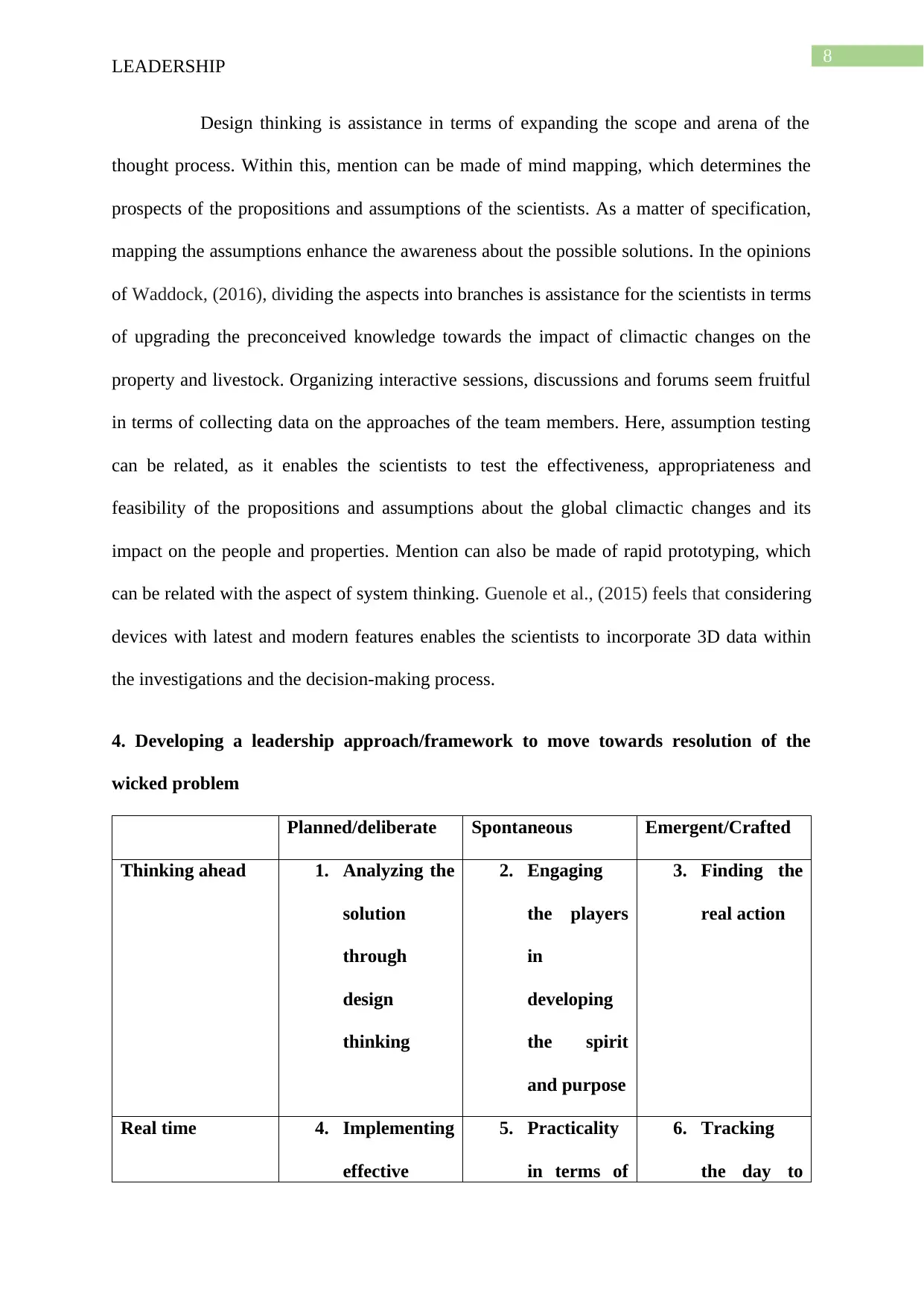
8
LEADERSHIP
Design thinking is assistance in terms of expanding the scope and arena of the
thought process. Within this, mention can be made of mind mapping, which determines the
prospects of the propositions and assumptions of the scientists. As a matter of specification,
mapping the assumptions enhance the awareness about the possible solutions. In the opinions
of Waddock, (2016), dividing the aspects into branches is assistance for the scientists in terms
of upgrading the preconceived knowledge towards the impact of climactic changes on the
property and livestock. Organizing interactive sessions, discussions and forums seem fruitful
in terms of collecting data on the approaches of the team members. Here, assumption testing
can be related, as it enables the scientists to test the effectiveness, appropriateness and
feasibility of the propositions and assumptions about the global climactic changes and its
impact on the people and properties. Mention can also be made of rapid prototyping, which
can be related with the aspect of system thinking. Guenole et al., (2015) feels that considering
devices with latest and modern features enables the scientists to incorporate 3D data within
the investigations and the decision-making process.
4. Developing a leadership approach/framework to move towards resolution of the
wicked problem
Planned/deliberate Spontaneous Emergent/Crafted
Thinking ahead 1. Analyzing the
solution
through
design
thinking
2. Engaging
the players
in
developing
the spirit
and purpose
3. Finding the
real action
Real time 4. Implementing
effective
5. Practicality
in terms of
6. Tracking
the day to
LEADERSHIP
Design thinking is assistance in terms of expanding the scope and arena of the
thought process. Within this, mention can be made of mind mapping, which determines the
prospects of the propositions and assumptions of the scientists. As a matter of specification,
mapping the assumptions enhance the awareness about the possible solutions. In the opinions
of Waddock, (2016), dividing the aspects into branches is assistance for the scientists in terms
of upgrading the preconceived knowledge towards the impact of climactic changes on the
property and livestock. Organizing interactive sessions, discussions and forums seem fruitful
in terms of collecting data on the approaches of the team members. Here, assumption testing
can be related, as it enables the scientists to test the effectiveness, appropriateness and
feasibility of the propositions and assumptions about the global climactic changes and its
impact on the people and properties. Mention can also be made of rapid prototyping, which
can be related with the aspect of system thinking. Guenole et al., (2015) feels that considering
devices with latest and modern features enables the scientists to incorporate 3D data within
the investigations and the decision-making process.
4. Developing a leadership approach/framework to move towards resolution of the
wicked problem
Planned/deliberate Spontaneous Emergent/Crafted
Thinking ahead 1. Analyzing the
solution
through
design
thinking
2. Engaging
the players
in
developing
the spirit
and purpose
3. Finding the
real action
Real time 4. Implementing
effective
5. Practicality
in terms of
6. Tracking
the day to
⊘ This is a preview!⊘
Do you want full access?
Subscribe today to unlock all pages.

Trusted by 1+ million students worldwide
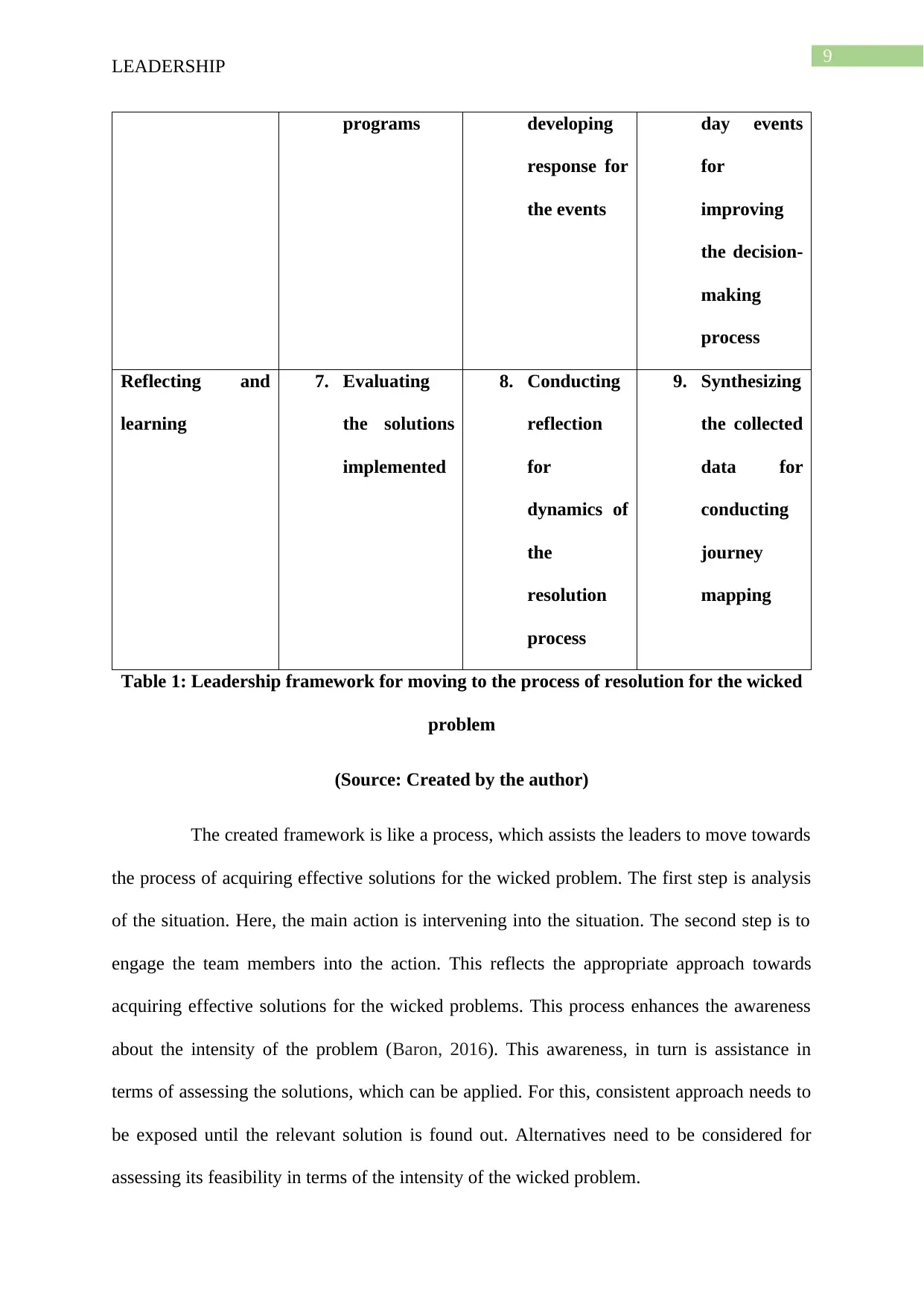
9
LEADERSHIP
programs developing
response for
the events
day events
for
improving
the decision-
making
process
Reflecting and
learning
7. Evaluating
the solutions
implemented
8. Conducting
reflection
for
dynamics of
the
resolution
process
9. Synthesizing
the collected
data for
conducting
journey
mapping
Table 1: Leadership framework for moving to the process of resolution for the wicked
problem
(Source: Created by the author)
The created framework is like a process, which assists the leaders to move towards
the process of acquiring effective solutions for the wicked problem. The first step is analysis
of the situation. Here, the main action is intervening into the situation. The second step is to
engage the team members into the action. This reflects the appropriate approach towards
acquiring effective solutions for the wicked problems. This process enhances the awareness
about the intensity of the problem (Baron, 2016). This awareness, in turn is assistance in
terms of assessing the solutions, which can be applied. For this, consistent approach needs to
be exposed until the relevant solution is found out. Alternatives need to be considered for
assessing its feasibility in terms of the intensity of the wicked problem.
LEADERSHIP
programs developing
response for
the events
day events
for
improving
the decision-
making
process
Reflecting and
learning
7. Evaluating
the solutions
implemented
8. Conducting
reflection
for
dynamics of
the
resolution
process
9. Synthesizing
the collected
data for
conducting
journey
mapping
Table 1: Leadership framework for moving to the process of resolution for the wicked
problem
(Source: Created by the author)
The created framework is like a process, which assists the leaders to move towards
the process of acquiring effective solutions for the wicked problem. The first step is analysis
of the situation. Here, the main action is intervening into the situation. The second step is to
engage the team members into the action. This reflects the appropriate approach towards
acquiring effective solutions for the wicked problems. This process enhances the awareness
about the intensity of the problem (Baron, 2016). This awareness, in turn is assistance in
terms of assessing the solutions, which can be applied. For this, consistent approach needs to
be exposed until the relevant solution is found out. Alternatives need to be considered for
assessing its feasibility in terms of the intensity of the wicked problem.
Paraphrase This Document
Need a fresh take? Get an instant paraphrase of this document with our AI Paraphraser
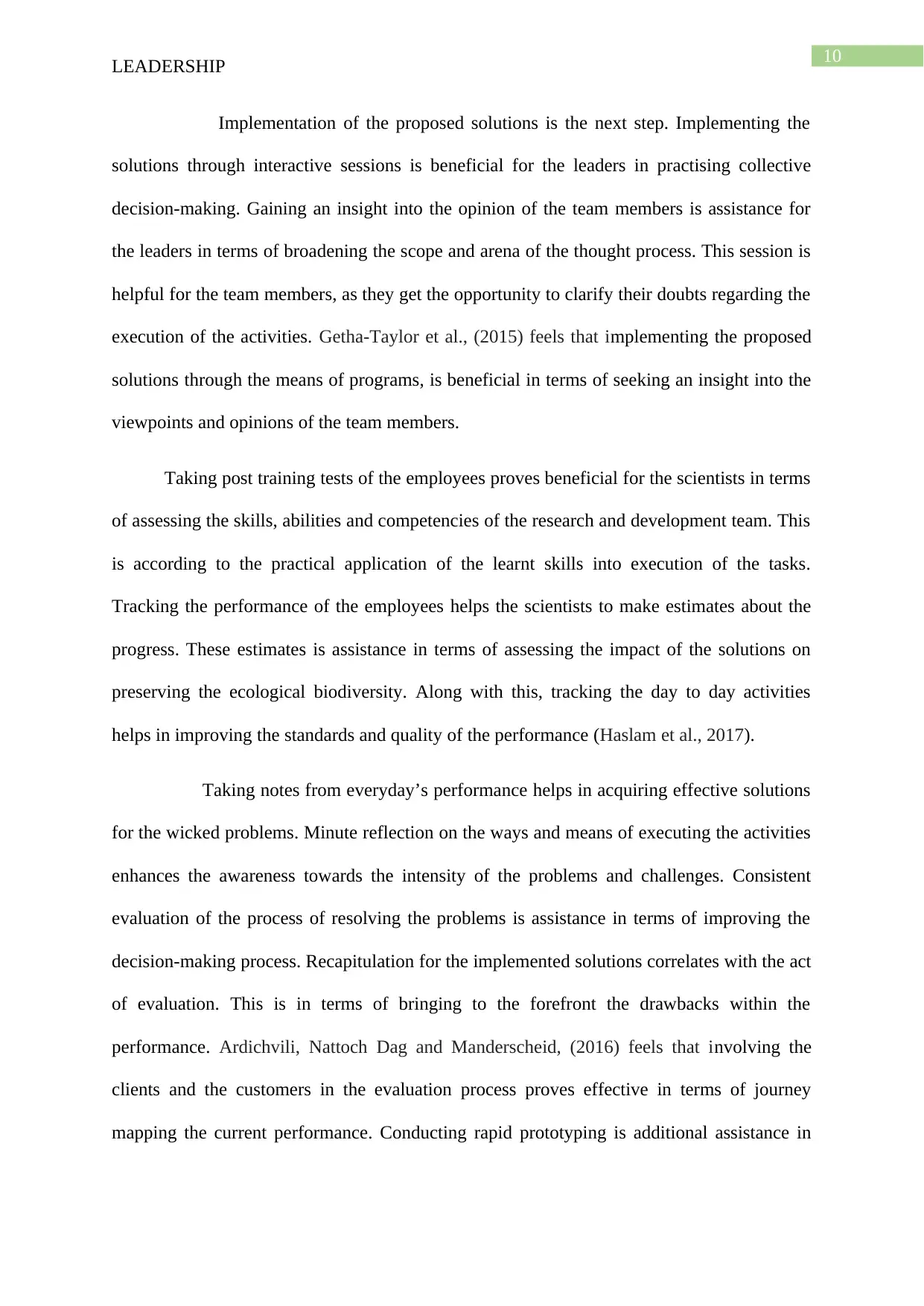
10
LEADERSHIP
Implementation of the proposed solutions is the next step. Implementing the
solutions through interactive sessions is beneficial for the leaders in practising collective
decision-making. Gaining an insight into the opinion of the team members is assistance for
the leaders in terms of broadening the scope and arena of the thought process. This session is
helpful for the team members, as they get the opportunity to clarify their doubts regarding the
execution of the activities. Getha-Taylor et al., (2015) feels that implementing the proposed
solutions through the means of programs, is beneficial in terms of seeking an insight into the
viewpoints and opinions of the team members.
Taking post training tests of the employees proves beneficial for the scientists in terms
of assessing the skills, abilities and competencies of the research and development team. This
is according to the practical application of the learnt skills into execution of the tasks.
Tracking the performance of the employees helps the scientists to make estimates about the
progress. These estimates is assistance in terms of assessing the impact of the solutions on
preserving the ecological biodiversity. Along with this, tracking the day to day activities
helps in improving the standards and quality of the performance (Haslam et al., 2017).
Taking notes from everyday’s performance helps in acquiring effective solutions
for the wicked problems. Minute reflection on the ways and means of executing the activities
enhances the awareness towards the intensity of the problems and challenges. Consistent
evaluation of the process of resolving the problems is assistance in terms of improving the
decision-making process. Recapitulation for the implemented solutions correlates with the act
of evaluation. This is in terms of bringing to the forefront the drawbacks within the
performance. Ardichvili, Nattoch Dag and Manderscheid, (2016) feels that involving the
clients and the customers in the evaluation process proves effective in terms of journey
mapping the current performance. Conducting rapid prototyping is additional assistance in
LEADERSHIP
Implementation of the proposed solutions is the next step. Implementing the
solutions through interactive sessions is beneficial for the leaders in practising collective
decision-making. Gaining an insight into the opinion of the team members is assistance for
the leaders in terms of broadening the scope and arena of the thought process. This session is
helpful for the team members, as they get the opportunity to clarify their doubts regarding the
execution of the activities. Getha-Taylor et al., (2015) feels that implementing the proposed
solutions through the means of programs, is beneficial in terms of seeking an insight into the
viewpoints and opinions of the team members.
Taking post training tests of the employees proves beneficial for the scientists in terms
of assessing the skills, abilities and competencies of the research and development team. This
is according to the practical application of the learnt skills into execution of the tasks.
Tracking the performance of the employees helps the scientists to make estimates about the
progress. These estimates is assistance in terms of assessing the impact of the solutions on
preserving the ecological biodiversity. Along with this, tracking the day to day activities
helps in improving the standards and quality of the performance (Haslam et al., 2017).
Taking notes from everyday’s performance helps in acquiring effective solutions
for the wicked problems. Minute reflection on the ways and means of executing the activities
enhances the awareness towards the intensity of the problems and challenges. Consistent
evaluation of the process of resolving the problems is assistance in terms of improving the
decision-making process. Recapitulation for the implemented solutions correlates with the act
of evaluation. This is in terms of bringing to the forefront the drawbacks within the
performance. Ardichvili, Nattoch Dag and Manderscheid, (2016) feels that involving the
clients and the customers in the evaluation process proves effective in terms of journey
mapping the current performance. Conducting rapid prototyping is additional assistance in
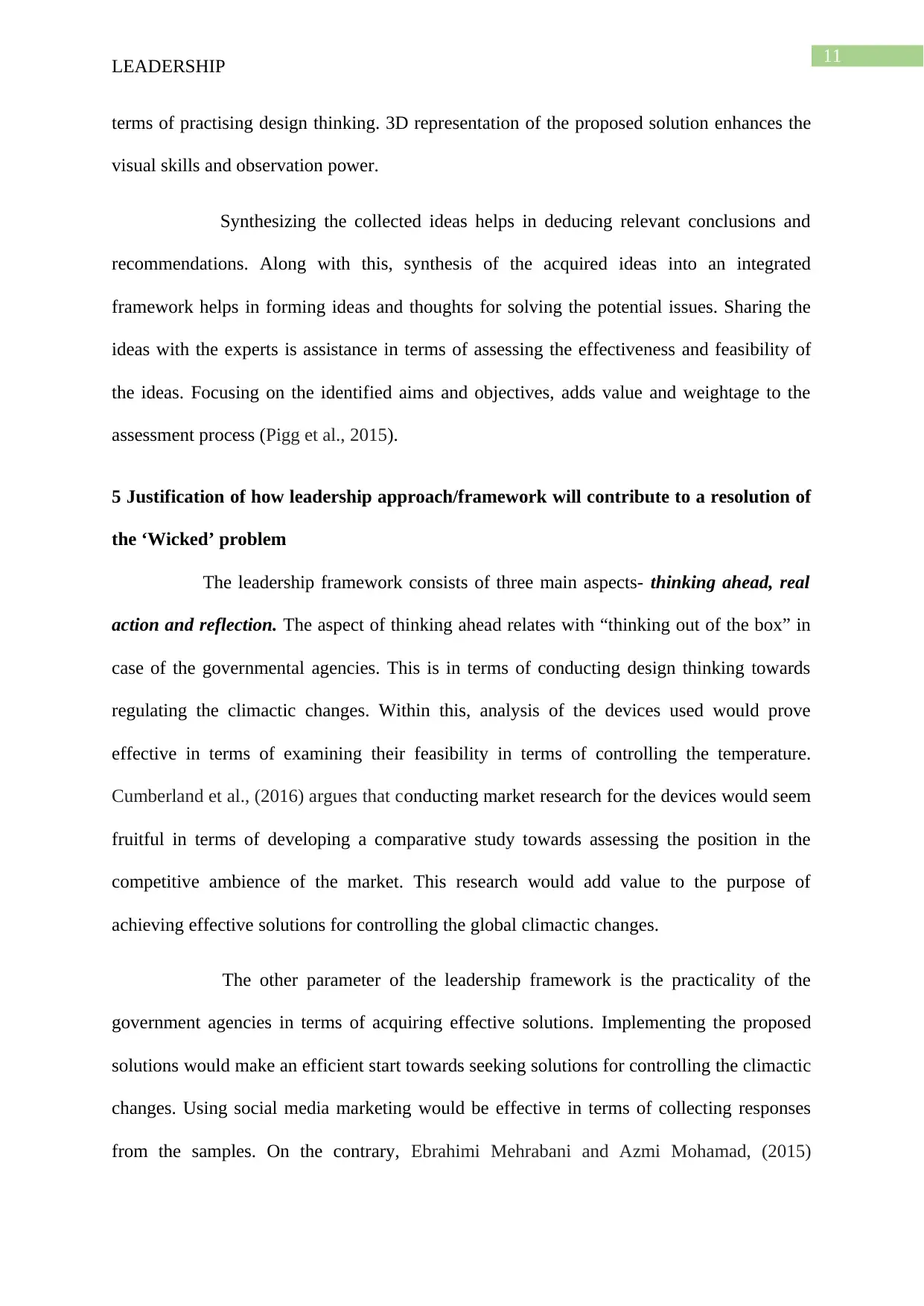
11
LEADERSHIP
terms of practising design thinking. 3D representation of the proposed solution enhances the
visual skills and observation power.
Synthesizing the collected ideas helps in deducing relevant conclusions and
recommendations. Along with this, synthesis of the acquired ideas into an integrated
framework helps in forming ideas and thoughts for solving the potential issues. Sharing the
ideas with the experts is assistance in terms of assessing the effectiveness and feasibility of
the ideas. Focusing on the identified aims and objectives, adds value and weightage to the
assessment process (Pigg et al., 2015).
5 Justification of how leadership approach/framework will contribute to a resolution of
the ‘Wicked’ problem
The leadership framework consists of three main aspects- thinking ahead, real
action and reflection. The aspect of thinking ahead relates with “thinking out of the box” in
case of the governmental agencies. This is in terms of conducting design thinking towards
regulating the climactic changes. Within this, analysis of the devices used would prove
effective in terms of examining their feasibility in terms of controlling the temperature.
Cumberland et al., (2016) argues that conducting market research for the devices would seem
fruitful in terms of developing a comparative study towards assessing the position in the
competitive ambience of the market. This research would add value to the purpose of
achieving effective solutions for controlling the global climactic changes.
The other parameter of the leadership framework is the practicality of the
government agencies in terms of acquiring effective solutions. Implementing the proposed
solutions would make an efficient start towards seeking solutions for controlling the climactic
changes. Using social media marketing would be effective in terms of collecting responses
from the samples. On the contrary, Ebrahimi Mehrabani and Azmi Mohamad, (2015)
LEADERSHIP
terms of practising design thinking. 3D representation of the proposed solution enhances the
visual skills and observation power.
Synthesizing the collected ideas helps in deducing relevant conclusions and
recommendations. Along with this, synthesis of the acquired ideas into an integrated
framework helps in forming ideas and thoughts for solving the potential issues. Sharing the
ideas with the experts is assistance in terms of assessing the effectiveness and feasibility of
the ideas. Focusing on the identified aims and objectives, adds value and weightage to the
assessment process (Pigg et al., 2015).
5 Justification of how leadership approach/framework will contribute to a resolution of
the ‘Wicked’ problem
The leadership framework consists of three main aspects- thinking ahead, real
action and reflection. The aspect of thinking ahead relates with “thinking out of the box” in
case of the governmental agencies. This is in terms of conducting design thinking towards
regulating the climactic changes. Within this, analysis of the devices used would prove
effective in terms of examining their feasibility in terms of controlling the temperature.
Cumberland et al., (2016) argues that conducting market research for the devices would seem
fruitful in terms of developing a comparative study towards assessing the position in the
competitive ambience of the market. This research would add value to the purpose of
achieving effective solutions for controlling the global climactic changes.
The other parameter of the leadership framework is the practicality of the
government agencies in terms of acquiring effective solutions. Implementing the proposed
solutions would make an efficient start towards seeking solutions for controlling the climactic
changes. Using social media marketing would be effective in terms of collecting responses
from the samples. On the contrary, Ebrahimi Mehrabani and Azmi Mohamad, (2015)
⊘ This is a preview!⊘
Do you want full access?
Subscribe today to unlock all pages.

Trusted by 1+ million students worldwide
1 out of 17
Related Documents
Your All-in-One AI-Powered Toolkit for Academic Success.
+13062052269
info@desklib.com
Available 24*7 on WhatsApp / Email
![[object Object]](/_next/static/media/star-bottom.7253800d.svg)
Unlock your academic potential
Copyright © 2020–2025 A2Z Services. All Rights Reserved. Developed and managed by ZUCOL.





